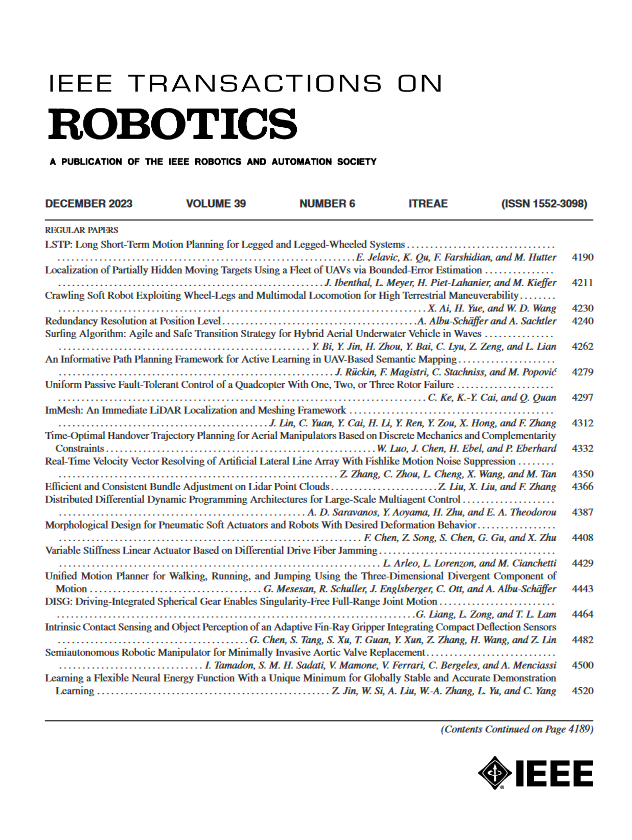ERPoT:基于轻量级多边形映射的移动机器人有效可靠的姿态跟踪
IF 10.5
1区 计算机科学
Q1 ROBOTICS
引用次数: 0
摘要
本文提出了一种有效可靠的姿态跟踪解决方案,称为ERPoT,用于在大规模室外和具有挑战性的室内环境中操作的移动机器人,以创新的先验多边形地图为基础。特别地,为了克服地图尺寸随着环境的扩展而增大所带来的挑战,提出了一种由多个多边形组成的新型先验地图。得益于使用多边形简洁准确地描绘环境占用,先验多边形地图在保证紧凑形式的同时,实现了长期可靠的姿态跟踪。更重要的是,在纯LiDAR模式下进行姿态跟踪,将密集的三维点云通过去地和障碍物选择转化为稀疏的二维扫描。在此基础上,引入了一种新的点多边形匹配姿态估计代价函数,该函数包含两种不同的约束形式:点到顶点和点到边。在本研究中,我们主要关注两个关键方面:轻量化和紧凑的先验地图构建,以及有效可靠的机器人姿态跟踪。这两个方面都是未来在不同环境下配备不同激光雷达传感器的不同移动平台上导航的基础支柱。在公开数据集和自记录数据集上进行了对比实验,结果表明ERPoT在可靠性、先验地图大小、姿态估计误差和运行时间上优于其他六种方法。对应的代码可以在线访问。本文章由计算机程序翻译,如有差异,请以英文原文为准。
ERPoT: Effective and Reliable Pose Tracking for Mobile Robots Using Lightweight Polygon Maps
This article presents an effective and reliable pose tracking solution, termed ERPoT, for mobile robots operating in large-scale outdoor and challenging indoor environments, underpinned by an innovative prior polygon map. Especially, to overcome the challenge that arises as the map size grows with the expansion of the environment, the novel form of a prior map composed of multiple polygons is proposed. Benefiting from the use of polygons to concisely and accurately depict environmental occupancy, the prior polygon map achieves long-term reliable pose tracking while ensuring a compact form. More importantly, pose tracking is carried out under pure LiDAR mode, and the dense 3-D point cloud is transformed into a sparse 2-D scan through ground removal and obstacle selection. On this basis, a novel cost function for pose estimation through point-polygon matching is introduced, encompassing two distinct constraint forms: point-to-vertex and point-to-edge. In this study, our primary focus lies on two crucial aspects: lightweight and compact prior map construction, as well as effective and reliable robot pose tracking. Both aspects serve as the foundational pillars for future navigation across diverse mobile platforms equipped with different LiDAR sensors in varied environments. Comparative experiments based on the publicly available datasets and our self-recorded datasets are conducted, and evaluation results show the superior performance of ERPoT on reliability, prior map size, pose estimation error, and runtime over the other six approaches. The corresponding code can be accessed online.
求助全文
通过发布文献求助,成功后即可免费获取论文全文。
去求助
来源期刊

IEEE Transactions on Robotics
工程技术-机器人学
CiteScore
14.90
自引率
5.10%
发文量
259
审稿时长
6.0 months
期刊介绍:
The IEEE Transactions on Robotics (T-RO) is dedicated to publishing fundamental papers covering all facets of robotics, drawing on interdisciplinary approaches from computer science, control systems, electrical engineering, mathematics, mechanical engineering, and beyond. From industrial applications to service and personal assistants, surgical operations to space, underwater, and remote exploration, robots and intelligent machines play pivotal roles across various domains, including entertainment, safety, search and rescue, military applications, agriculture, and intelligent vehicles.
Special emphasis is placed on intelligent machines and systems designed for unstructured environments, where a significant portion of the environment remains unknown and beyond direct sensing or control.
 求助内容:
求助内容: 应助结果提醒方式:
应助结果提醒方式:


